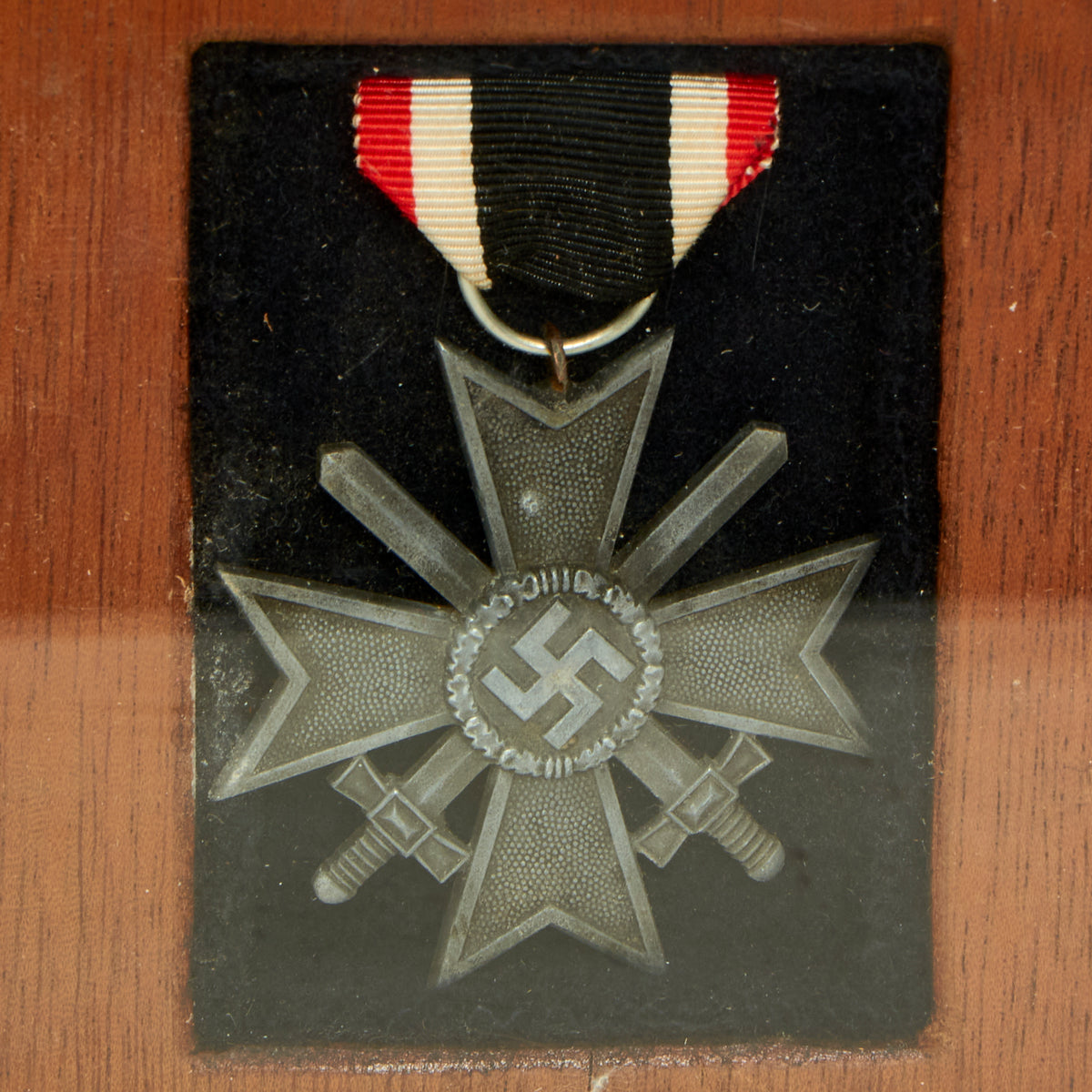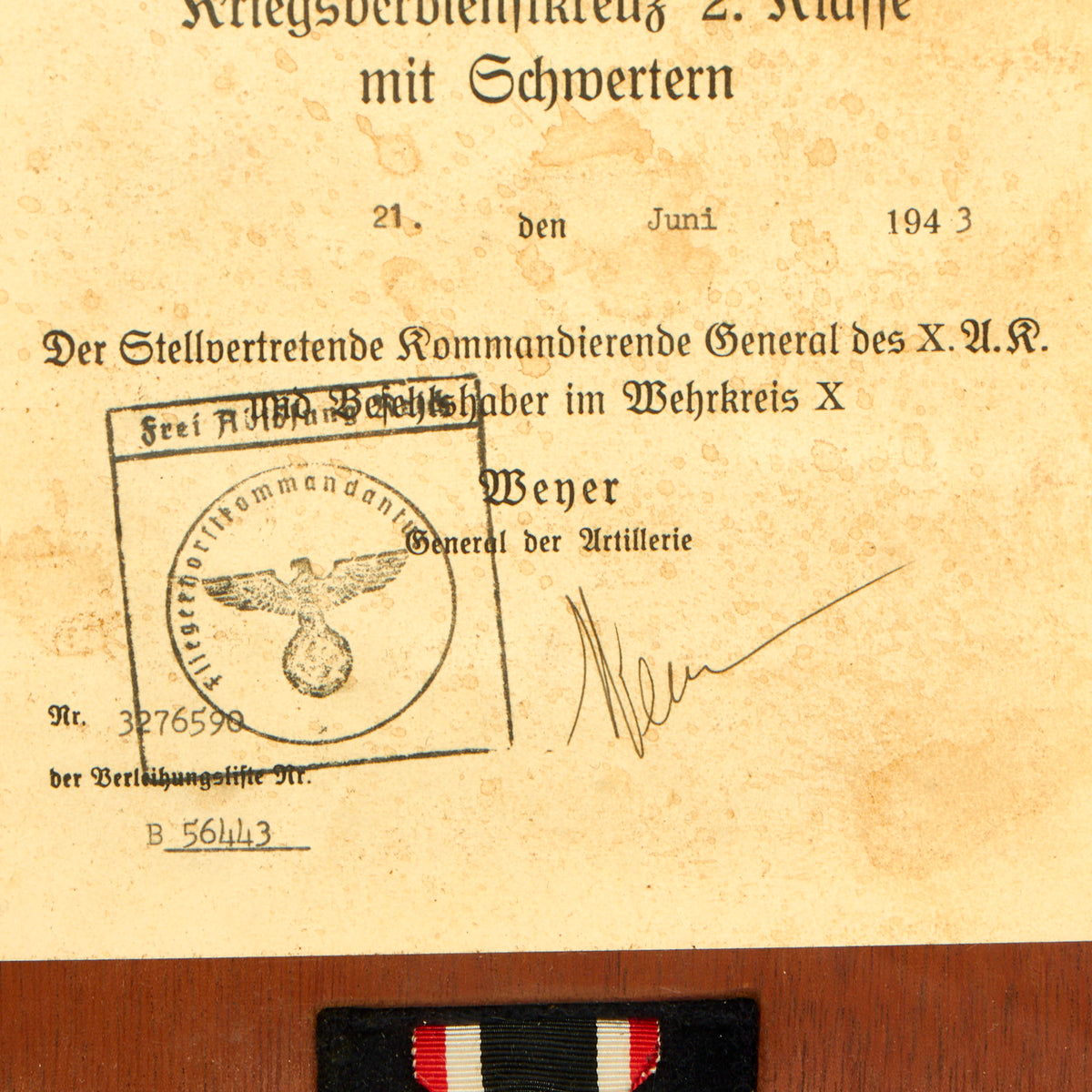Original German WWII Framed War Merit Cross 2nd Class with Swords and Named 6th Panzer Division Award Document Original Items
$ 350,00 $ 105,00
Original Items: One-of-a-kind. This is a very nice original German WWII War Merit Cross 2nd Class (KvK II) with swords, complete with its original named Besittzzeugnis “possession/award” certificate. The framed document measures approximately 12 ½” x 7 ½”, and is printed on mid-weight paper with black print and typed in particulars.
It indicates that Oberfeldwebel Ernst Maürer of 6/Pz. Regt. 21 (6th Panzer Division Regiment 21) was awarded the KRIEGSVERDIENSTKREUZ 2. KLASSE MIT SCHWERTEN on 21. Juni 1943. The document has the proper stamps and for issue, and has the signature of General der Artillerie Weber stamp present.
The document is in very good condition as it has been framed for quite some time. The medal itself is also in very good shape, with minimal oxidation on the cross, and a good condition rayon ribbon.
A really nice named German WWII Medal, complete with a named award document. Ready to display!
The 6th Panzer Division was an armored division in the German Army, the Heer, during World War II, established in October 1939.
The division, initially formed as a light brigade, participated in the invasions of Poland, Belgium, France and the Soviet Union. From 1941 to 1945 it fought on the Eastern Front, interrupted only by periods of refitting spent in France and Germany. It eventually surrendered to US forces in Czechoslovakia in May 1945 but was handed over to Soviet authorities, where the majority of its remaining men would be imprisoned in Gulag hard labor camps.
The 1st Light Brigade was a mechanized unit established in October 1937 in imitation of the French Division Légère Mécanique. It was intended to take on the roles of army-level reconnaissance and security that had traditionally been the responsibility of cavalry. It included mechanized reconnaissance units, motorized infantry, and a battalion of tanks. The concept of the Light Brigade, of which three were planned by the Wehrmacht, quickly showed its flawed nature and was abandoned.
In April 1938 the brigade was enlarged to become the 1st Light Division, receiving the 11th tank regiment as an attachment for its participation in the occupation of the Sudetenland in October 1938 and the subsequent disestablishment of Czechoslovakia in March 1939. Following the latter the division received 130 Czech-built tanks which were superior to the Panzer I and Panzer II the division had been equipped with. In 1939, the division fought in the Invasion of Poland.
Due to shortcomings that the campaign revealed in the organization of the Light divisions, it was reorganized as the 6th Panzer Division in October 1939, as were the other three light divisions which became the 7th, 8th and 9th Panzer Divisions.
As the 6th Panzer Division, it participated in the 1940 Battle of France. The division contained a single panzer regiment, the Panzer-Regiment 11, which in turn contained three Abteilungen, or battalions. The 11th Regiment was equipped with 75 Czech-built Panzer 35(t) tanks, which proved efficient but difficult to maintain because the maintenance manuals were in Czech rather than German, and spare parts were less readily supplied and harder to easily requisition as a result. Furthermore, there were six Befehlspanzer 35(t), which were a subtype of the 35(t) designed for military commanders, as well as 45 Panzer II and 27 Panzer IV.
The division was part of the German advance to the English Channel through Belgium. It then swung back towards the French-Swiss border before relocating to Eastern Prussia in September 1940 where it remained until June 1941.
At the time of the German invasion of the Soviet Union the division had 239 tanks, but only twelve of those were Panzer III, which still struggled to pierce the armor of Soviet tanks such as the T-34 and KV-1. In June 1941, it joined Operation Barbarossa, fighting at first under Army Group North for Leningrad. At the Battle of Raseiniai two of its Kampfgruppen consisted of:
Fast Shipping with Professional Packaging
Thanks to our longstanding association with UPS FedEx DHL, and other major international carriers, we are able to provide a range of shipping options. Our warehouse staff is expertly trained and will wrap your products according to our exact and precise specifications. Prior to shipping, your goods will be thoroughly examined and securely secured. We ship to thousands clients each day across multiple countries. This shows how we're dedicated to be the largest retailer on the internet. Warehouses and distribution centres can be located throughout Europe as well as the USA.
Note: Orders with more than one item will be assigned a processing date depending on the item.
Before shipping before shipping, we'll conduct a thorough inspection of the items you have ordered. Today, the majority of orders will be delivered within 48 hours. The delivery time will be between 3-7 days.
Returns
The stock is dynamic and we cannot completely manage it because multiple stakeholders are involved, including our factory and warehouse. So the actual stock may alter at any time. It's possible that you may not receive your order once the order has been made.
Our policy is valid for a period of 30 days. If you don't receive the product within 30 days, we are not able to issue a refund or an exchange.
You can only return an item if it is unused and in the same state as the day you received it. You must have the item in its original packaging.
Related products
Uncategorized
Uncategorized
Uncategorized
Uncategorized
Australian WWII Owen MK1 Machine Carbine SMG Custom Fabricated Replica with Sling Original Items
Uncategorized
Uncategorized
Uncategorized
Uncategorized
Uncategorized
Band of Brothers ORIGINAL GERMAN WWII Le. F.H. 18 10.5cm ARTILLERY PIECE Original Items
Uncategorized
Uncategorized
Uncategorized
Uncategorized
Uncategorized
Uncategorized
Uncategorized
Uncategorized
Uncategorized
Uncategorized











































































